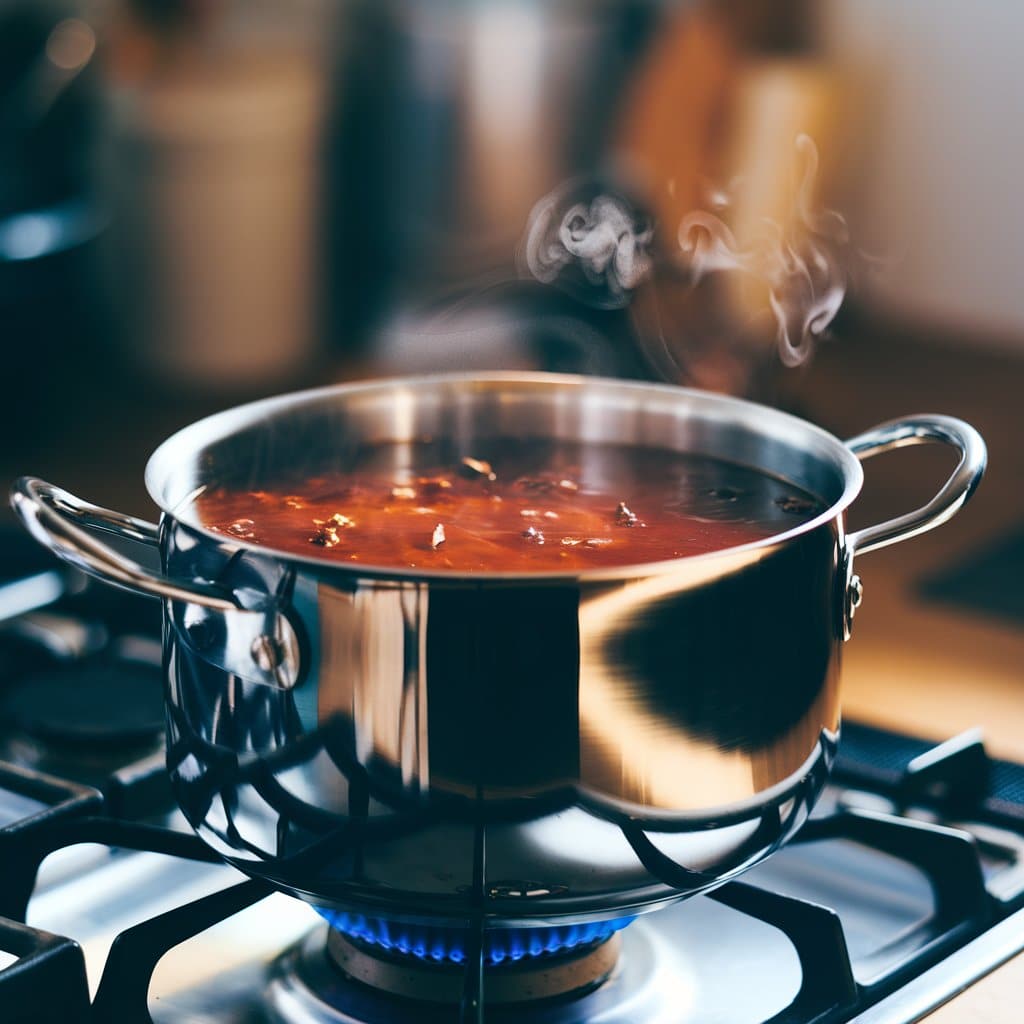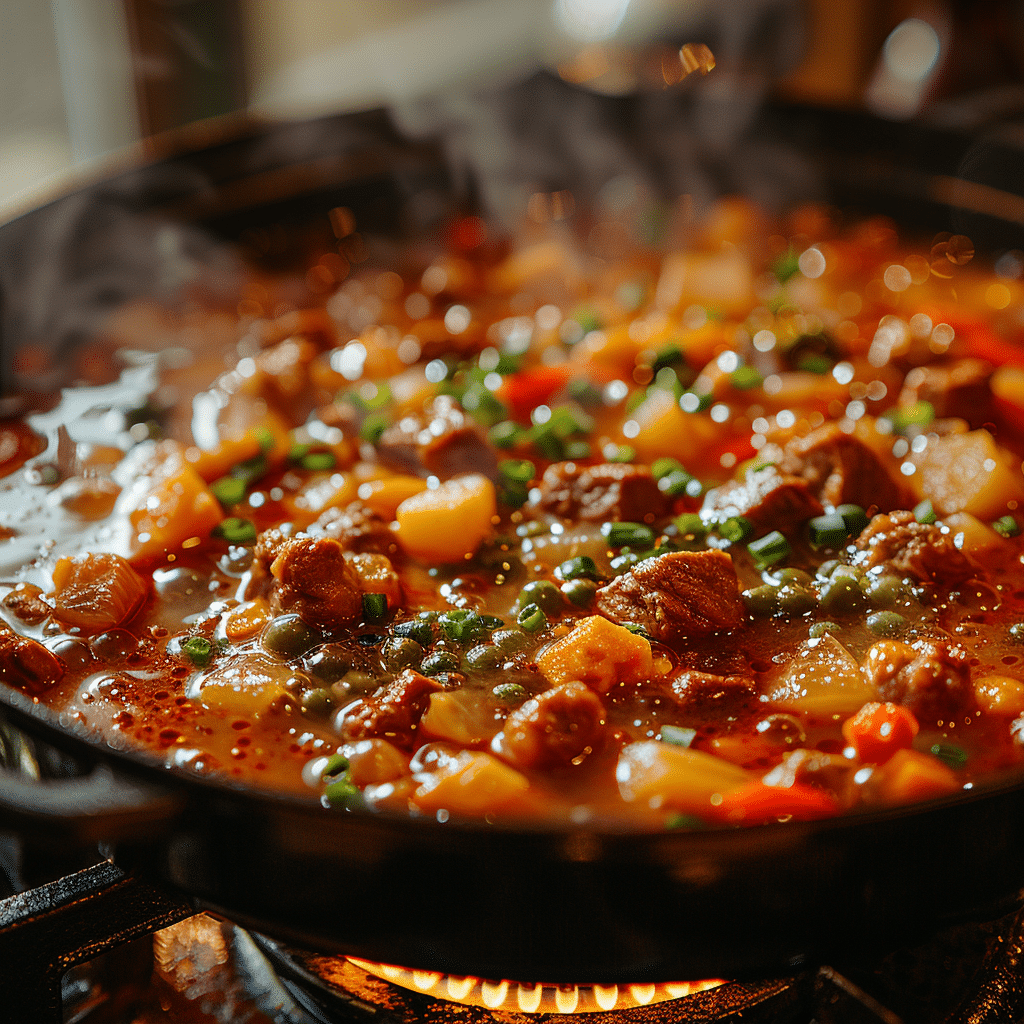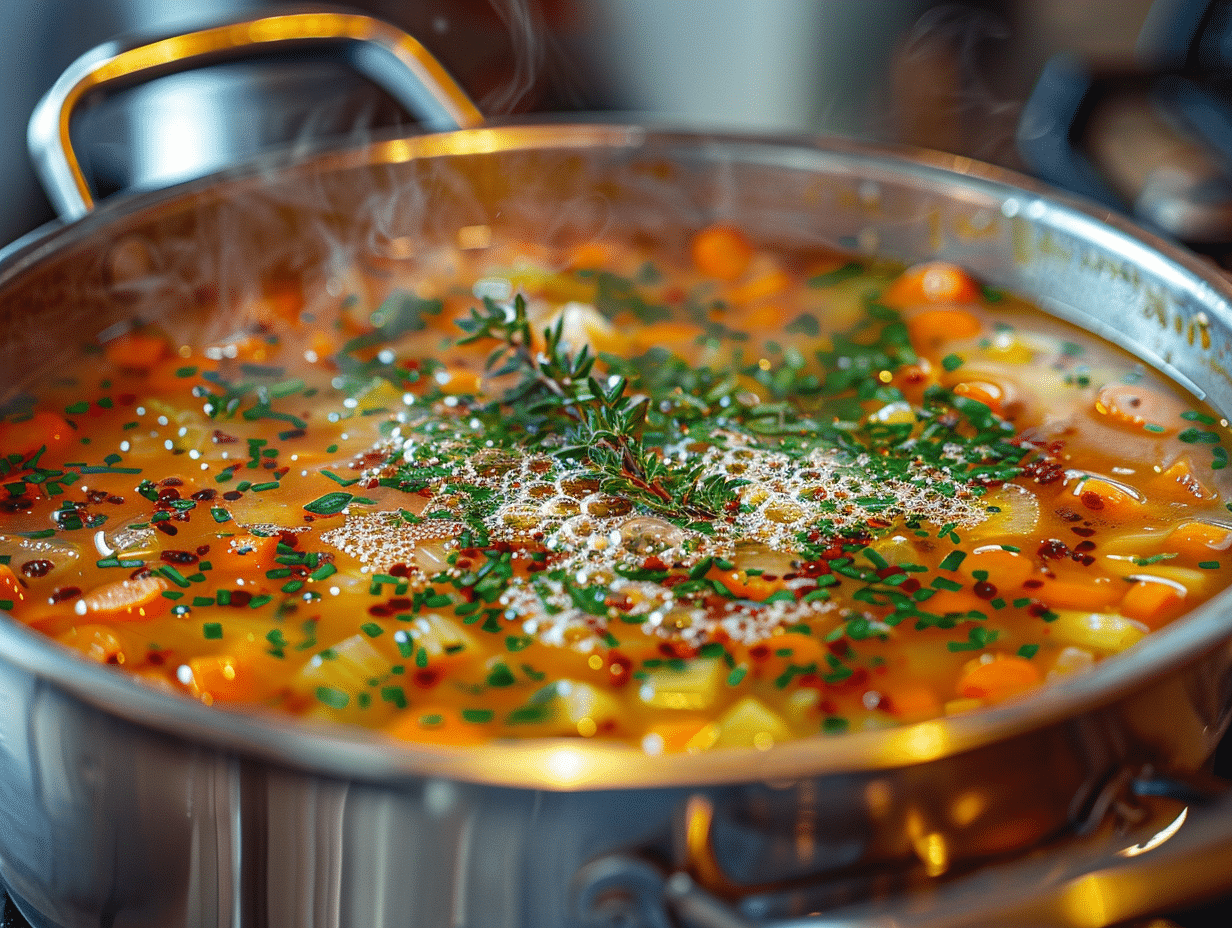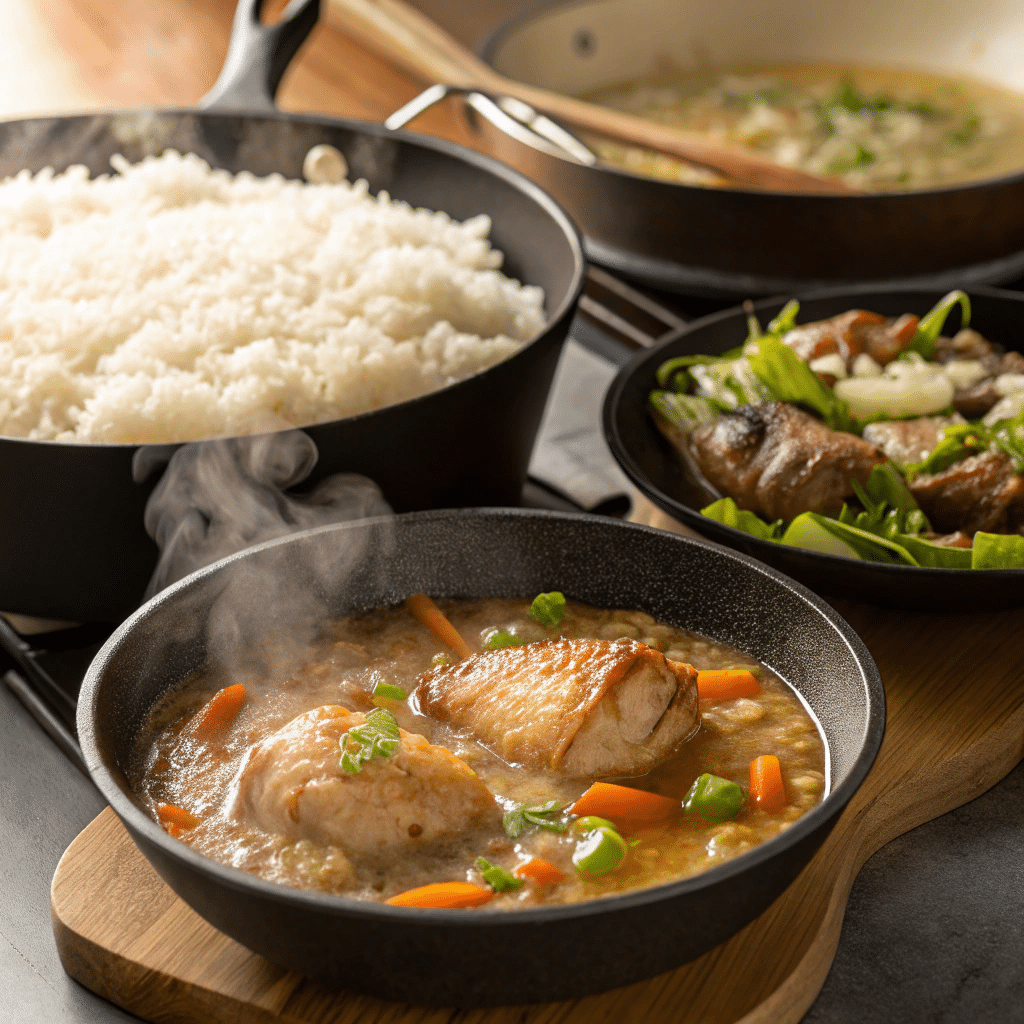What is Simmering in Cooking? A Step-by-Step Guide
Have you ever thought about why some soups and stews are so rich and comforting in flavor? The key is a gentle cooking technique known as simmering. This method turns basic ingredients into tasty meals with little effort.
Simmering is cooking food at a temperature just below boiling. This method uses gentle bubbles and smooth movements in the liquid, unlike boiling, which can be rough. It’s great for making soups, stews, and broths that are full of flavor.
This guide will take you through each step of the process. You will discover how to manage the heat, select the appropriate pot, and reach the ideal temperature. Prepare to learn this important cooking skill and take your meals to a higher standard!

What is Simmering in Cooking?
Have you ever noticed how some dishes have a rich flavor that seems almost magical? That’s the magic of simmering. This cooking method is gentle and turns basic ingredients into something amazing. Simmering uses low and steady heat, unlike boiling, which can be intense.
Learning About Simmering Temperatures
Simmering occurs between 185 and 205 degrees Fahrenheit. At this level, the liquid has small bubbles that rise to the surface. It’s not boiling vigorously, but rather a gentle, consistent motion. This gentle heat allows ingredients to cook evenly without falling apart.
I’ve discovered that maintaining the heat at this level works well for soups, stews, and sauces. It helps flavors blend nicely without cooking delicate vegetables or meats too much. The outcome? Soft, tasty meals that give you a comforting feeling.
Benefits of a Gentle Cooking Method
Simmering offers many benefits. It keeps the texture of the ingredients and creates deep, layered flavors. I really enjoy how it allows me to make filling meals with little effort. The gentle steam and soft bubbling fill the kitchen with a wonderful aroma.
This method works well for foods such as pasta, beans, and soups. It’s a method of cooking food at a slow pace, allowing each ingredient to stand out. When you make a pot of soup or a tasty stew, simmering helps all the flavors blend together nicely.

Simmering vs. Boiling: Key Differences
What is the actual difference between small bubbles and big bubbles? The heat is what changes your dish. Simmering and boiling may look alike, but they lead to very different outcomes. Knowing these differences can improve your cooking skills.
Visual and Temperature Signals
Boiling water creates a vibrant atmosphere. Bubbles rise quickly, and the surface is always moving. The temperature here is about 212°F, which is great for cooking pasta or blanching vegetables. However, it may be too strong for gentle ingredients.
Simmering is gentle and consistent. Small, soft bubbles appear on the surface at temperatures between 185 and 205°F. This lower heat works well for soups, stews, and sauces. It allows flavors to blend together without overcooking or damaging the ingredients.
Why Choose a Simmer Over a Boil?
I usually select a simmer for recipes that require time and attention. It keeps meats soft and vegetables whole. Boiling can make proteins tough or cause vegetables to become mushy. A rolling boil can overcook chicken in a soup, but a gentle simmer helps keep it juicy.
It’s important to reduce the heat after the water starts boiling. It stops any stirring and makes sure everything cooks evenly. Simmering is the best method for creating a rich broth or a hearty stew, as it enhances the flavor and gives the perfect texture.
Helpful Tools and Tips for Ideal Simmering
The right tools can really help you achieve the perfect simmer. When you’re preparing a hearty stew or a delicate sauce, using the right tools helps distribute heat evenly and stops it from boiling over. Let’s explore the key elements that will enhance your cooking skills.

Essential Cookware and Accessories
Begin with a pot that has a thick bottom. These pots spread heat evenly, which helps avoid hot spots that can lead to uneven cooking. A 5-quart Dutch oven works well for most recipes. It is flexible and holds heat effectively, which makes it perfect for extended cooking periods.
Flame tamer rings are really helpful accessories. They are placed between the burner and the pot, which helps lower the heat and keeps a gentle simmer going. A slotted spoon is essential for skimming foam or taking out ingredients without disturbing the liquid.
An instant-read thermometer is my go-to tool. It allows me to keep track of the temperature, making sure it remains between 185-205°F. This helps me prevent boiling by accident and preserves the flavors.
Adjusting Burner Settings
Keeping the right temperature is important. First, heat your liquid until it boils, then lower the heat to a gentle simmer. I prefer using the smallest burner on my stovetop for more control. If the bubbles are too strong, reduce the heat a bit. If they are moving too slowly, increase the speed a little.
I’ve found that partially covering the pot can be helpful. This holds in some heat while letting steam out, stopping it from boiling over. It’s an easy method to maintain everything stable and manageable.
Using the right tools and practicing a bit, you can easily learn how to simmer well. Your soups, stews, and sauces will always be rich, flavorful, and cooked just right.
A Simple Guide to Get the Perfect Simmer
To master simmering, begin with the proper setup and pay close attention to the details. This process turns basic ingredients into delicious, flavorful meals. Let’s go over the steps to get that perfect simmer every time.
Getting Your Pot and Ingredients Ready
Start by selecting a pot with a thick bottom. This helps to spread heat evenly, stopping hot spots that could spoil your meal. I always look at the bottom of the pot to ensure it’s strong and thick.
Next, pour in cold liquid such as water or stock into the pot. Cold liquids warm up slowly, which is important for reaching the correct temperature. Add your ingredients—vegetables, meat, or grains—and stir everything gently.
Moving from a boil to a simmer
Set the heat to high and let the liquid come to a boil. You will notice large, round bubbles popping on the surface. When it starts to boil, turn the heat down to low. This is the place where amazing things occur.
Look for small, consistent bubbles to appear. These indicate a good simmer. If the bubbles are too strong, reduce the heat a bit. If they are moving too slowly, increase the speed a little. It’s all about discovering the perfect balance.
Keeping an Eye on Temperature and Consistency
Watch the temperature closely. A simmer should be kept between 185 and 205 degrees Fahrenheit. I use a quick-read thermometer to make sure it’s accurate. This helps stop accidental boiling, which can make meat tough or overcook vegetables.
Stir now and then to ensure everything cooks evenly. The smell of your dish will fill the kitchen, showing that the flavors are coming together nicely. Patience is important—taking your time leads to great results.
By following these steps, you will make soups, stews, and sauces that are rich in flavor and cooked just right. Enjoy your cooking!

Controlling Temperature and Liquid Flow
Your eyes and senses are your most useful tools in the kitchen. When simmering, it’s important to keep an eye on the liquid. Small, consistent bubbles will lead the way. The heat is perfect, making the food tender and the flavors deep.
I begin by heating the liquid until it boils. When it starts to bubble strongly, I turn down the heat. This is the place where amazing things occur. The bubbles decrease in speed, and the surface settles into stillness. This is the ideal method for cooking soups, stews, and stocks without overcooking the ingredients.
Watching with Visual Signals
Watch for tiny bubbles slowly moving up to the top. If they are too large or quick, the heat is too intense. If there is hardly any movement, it is too low. Move the burner a little to discover the perfect setting. Trust your feelings—your sight and smell will lead you.
I use a thermometer to ensure accuracy. The best temperature for simmering is between 185 and 205 degrees Fahrenheit. This helps the food cook evenly while keeping its texture intact. This is an easy method to prevent accidental boiling, which can make meat tough or cause vegetables to break down.
Keep in mind that a gentle simmer is important. It helps flavors blend nicely, making dishes that are hearty and satisfying. No matter if you’re preparing a rich stew or a light soup, taking your time and focusing on the details will always be worthwhile.
Techniques for Simmering Different Foods
Each ingredient has a unique story, and simmering brings it out wonderfully. This gentle cooking method works well with various foods, bringing out their special flavors and textures. Simmering is essential for making meat tender, bringing grains back to life, and creating flavorful stocks.
Cooking Meats and Poultry Slowly
Simmering is great for meat and poultry. Low heat softens tough fibers, resulting in tender and juicy meat. I enjoy watching a chicken breast change in a pot of softly simmering broth. It takes time, but the outcome is amazing—tender, tasty meat that just melts in your mouth.
Simmering is great for tougher cuts, such as beef brisket. The liquid keeps the meat juicy, and the consistent heat brings out rich, tasty flavors. Include herbs and spices, and you’ll create a dish that is flavorful and satisfying.
Cooking Vegetables and Grains Slowly
Vegetables and grains grow well with mild warmth. Simmering keeps their texture intact and brings out their natural sweetness. I frequently cook carrots and potatoes in water for soups. They become soft but maintain their form, enhancing the flavor of each bite.
Rice and quinoa also have advantages. Cooking them in broth instead of water gives more flavor. The grains take in the liquid, turning soft and fragrant. This is an easy method to enhance any meal.
Making Stocks and Sauces
Simmering is essential for making stocks and sauces. It draws out flavors from bones, vegetables, and herbs, making a tasty base for soups and stews. I begin with cold water and heat it until it boils, then I reduce the heat. Cooking slowly lets each ingredient stand out.
Sauces become richer when they are simmered. As a tomato sauce cooks, it becomes richer and more complex. The smell spreads through the kitchen, showing that the flavors are coming together nicely.
Try out these techniques in your own kitchen. Simmering is a flexible cooking technique that works well with any dish, enhancing the flavors of all the ingredients.

Common Mistakes When Simmering and How to Prevent Them
Have you ever felt that your dish lost its charm while cooking? Making mistakes while simmering is common, but the good news is that they are easy to correct. Let’s look at some common mistakes and how to avoid them.
Cooking Food Too Much and Losing Nutrients
One of the biggest errors is applying too much heat. High temperatures can cook food too much, resulting in it being tough or mushy. I’ve found that maintaining a consistent heat is important. Cooking at a gentle simmer keeps the texture and taste of your ingredients intact.
Boiling too hard can cause nutrients to be lost. Vegetables, especially, lose vitamins when they are exposed to too much heat. I always keep the temperature between 185-205°F to prevent this. This makes sure the food cooks evenly while keeping its nutritional value intact.
Poor Liquid Management
A frequent problem is not handling the liquid correctly. Using too much water can weaken the flavor, but not enough can make the food stick to the pot. I prefer to begin with enough liquid to cover the ingredients. If it decreases too much, I add a little more to maintain balance.
Stirring from time to time helps spread the heat evenly and stops food from sticking. It’s an easy step, but it really matters. Keeping an eye on the pot helps maintain the right liquid level and ensures the food cooks evenly.
Advice for a Consistent Simmer
Keeping a steady simmer takes some practice, but it’s definitely worth it. I begin by boiling the liquid, then I lower the heat. This creates an ideal setting for small, soft bubbles to develop.
A heavy-bottomed pot helps spread heat evenly. I suggest covering the pot partway to keep some heat in while letting steam out. These small changes help maintain a steady simmer and stop it from boiling over.
Keep in mind that mistakes occur, but they can be easily fixed. By paying attention and practicing a bit, you will become skilled at simmering. Your meals will be tastier, more delicious, and cooked just right each time.
Useful Uses: Soups, Stews, and Beyond
A slow simmer can transform basic ingredients into something truly special. This method enhances the flavors in both a rich stew and a light soup. The gentle heat helps flavors blend together, making meals that are rich, comforting, and memorable.
Improving Tastes with Slow Cooking
For instance, consider French onion soup. The onions cook slowly, bringing out their natural sweetness. A gentle simmer allows the broth to take in their flavor, creating a depth that cannot be hurried. The first time I tried it, the smell filled the kitchen, and each spoonful was a surprise.
This method also helps hearty stews. Cooking at low heat makes tough cuts of meat tender and delicious, so they practically melt in your mouth. Vegetables become tender while still keeping their shape, providing texture and balance. It takes time, but the results make it all worthwhile.
Even sauces change when they are gently simmered. A tomato sauce gets richer and more complex as it cooks. The liquid thickens, bringing out the flavors, while herbs and spices enhance each bite. Cooking becomes an art form through a rich sensory experience.
Try out these techniques in your kitchen. Enjoy a classic chicken noodle soup or a spicy chili. Allow the heat to do its job, and see how basic ingredients blend together beautifully. Simmering is easy to learn, flexible, and very satisfying—it’s a skill that every home cook should know.
In conclusion
Simmering carefully reveals the essence of each dish. This method uses low heat, which is gentler than boiling, to keep the texture and enhance the flavors. It’s great for soups, stews, and sauces, allowing each ingredient to stand out.
In this guide, we have looked at the tools and methods to master this skill. By selecting the right pot and controlling the flow of liquids, you can make sure your food cooks evenly and looks great. Being patient and practicing is essential.
Try out new things in your kitchen. Enjoy a filling stew or a light broth. Change the heat, observe the bubbles, and rely on your intuition. Getting good at something takes time, but the benefits are definitely worth it.
Thank you for being a part of this cooking adventure. I would really like to hear about your success stories that are developing over time. Share them with me, and let’s enjoy the joy of cooking together. Food is not just about filling our stomachs; it’s about love, imagination, and bringing people together.
FAQ
How can I tell if my liquid is simmering?
Keep an eye out for light steam and soft bubbles rising to the top. The liquid should move gently, but not strongly like it does when boiling.
How can I best adjust the heat for a simmer?
Begin by boiling your liquid, then lower the burner to a low or medium-low setting. Watch the pot to ensure it keeps moving smoothly and steadily.
Can I simmer in any kind of pot?
A pot with a heavy bottom is ideal for distributing heat evenly. Stay away from thin pots, as they can create hot spots and lead to uneven cooking.
How long should I cook soup or stew on low heat?
It varies with the ingredients, but generally, most soups and stews improve with cooking for at least 30 minutes to an hour. This helps the flavors blend and makes the meats tender.
What is the difference between simmering and boiling pasta?
Simmering pasta means keeping the water just below boiling, which helps avoid overcooking. Boiling can cause pasta to become overly soft or sticky.
How does simmering improve the flavor of dishes?
The gentle heat helps ingredients share their flavors gradually, resulting in a richer and more complex taste in soups, stews, and sauces.
Is it possible to simmer without a lid?
Yes, a pot that is partially covered helps keep moisture and heat inside. To reduce liquids, keep it uncovered.
What is the best temperature for simmering?
Simmering usually happens between 185°F and 205°F, which is just below the boiling point of water.
What can I do to stop vegetables from getting overcooked while simmering?
Put them in later while cooking, especially tender vegetables like peas or spinach, to keep them bright and crunchy.
Is it possible to simmer stock for too long?
Yes, cooking stock for more than 4-6 hours can make it taste bitter. Watch the time to get the best results.